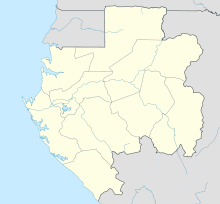Andende
Koordinaten: 0° 41′ S, 10° 13′ O
Der Stadtteil Andende der Provinzhauptstadt Lambaréné in Gabun befindet sich am rechten Ufer des Ogooué gegenüber einer Insel, die als heutiger Standort des Albert-Schweitzer-Hospitals bekannt wurde.
Er geht auf eine um 1876 gegründete US-amerikanische christliche Missionsstation von John Nassau zurück, die 1892 von der evangelischen Pariser Missionsgesellschaft übernommen wurde. Während einer Reise durch Äquatorialafrika besuchte die Engländerin Mary Kingsley die Missionsstation Andende als einen Etappenort ihrer Gabun-Bereisung.[1]
Als Albert Schweitzer im Jahr 1913 in Lambaréné eintraf, nutzte er zunächst die Missionsstation von Andende als provisorische Unterkunft und Krankenhaus, bis das eigentliche Hospital fertiggestellt wurde.[2] Die Missionsstation besteht aus zwei Backsteingebäuden, die seit etwa 120 Jahren dem tropischen Klima widerstanden – während alle Holzgebäude der ersten Missionsstation längst verrottet sind. Das Hauptgebäude besitzt im Erdgeschoss eine eindrucksvolle Gewölbegalerie. Die Wände der Station sind mit schlichten christlichen Bildmotiven verziert.[3]
Literatur
[Bearbeiten | Quelltext bearbeiten]- Nils Ole Oermann: Albert Schweitzer: Eine Biographie (1875–1965). C.H. Beck, München 2010, ISBN 978-3-406-59127-3, S. 132–33 (eingeschränkte Vorschau in der Google-Buchsuche).
- Mylène Rémy: Gabun in Farbe. Reisen heute. Jeune Afrique, Paris 1977, ISBN 2-85258-070-5, Lambaréné, S. 140–141 (französisch).
- Albert Schweitzer: a biography Von James Brabazon, Seite 239
- Eunjin Park: "White" Americans in "Black" Africa. In: Studies in African American History and Culture. Routledge, New York, NY 2001, ISBN 0-8153-4027-3 (englisch).
Weblinks
[Bearbeiten | Quelltext bearbeiten]- Spital (Andende 1924-1927) mit Foto
Einzelnachweise
[Bearbeiten | Quelltext bearbeiten]- ↑ Mary H. Kingsley: Travels in West Africa. 2004, S. 59, abgerufen am 4. Februar 2011 (englisch): „(CHAPTER VI. LEMBARENE) …The amount of work M. and Mme. Jacot used to get through was, to me, amazing, and I think the Ogowé Protestant mission sadly short-handed - its missionaries not being content to follow the usual Protestant plan out in West Africa, namely, quietly sitting down and keeping house, with just a few native children indoors to do the housework, and close by a school and a little church where a service is held on Sundays. The representatives of the Mission Évangélique go to and fro throughout the district round each station on evangelising work, among some of the most dangerous and uncivilised tribes in Africa, frequently spending a fortnight at a time away from their homes, on the waterways of a wild and dangerous country. In addition to going themselves, they send trained natives as evangelists and Bible-readers, and keep a keen eye on the trained native, which means a considerable amount of worry and strain too. The work on the stations is heavy in Ogowé districts, because when you have got a clearing made and all the buildings up, you have by no means finished with the affair, for you have to fight the Ogowé forest back, as a Dutchman fights the sea. But the main cause of work is the store, which in this exhausting climate is more than enough work for one man alone.“
- ↑ Nils Ole Oermann: Albert Schweitzer: Eine Biographie (1875–1965). 2010, S. 132.
- ↑ Mylène Rémy: Gabun in Farbe. 1977, Lambaréné, S. 140 (französisch).
